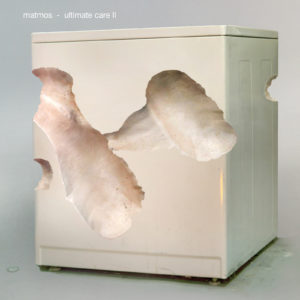 Well. You have two choices.
Well. You have two choices.
1. What Baltimore-based duo Matmos does on its latest set, “Ultimate Care II,” is outlandishly obnoxious and unapologetically pretentious. A single 38-minute track fueled by only washing machines, it works best as background music and even then, you’re being kind. Who on earth even has the time to deal with such an off-the-wall idea? It’s an exercise in ego and why would anyone ever be interested in this blatantly weird-for-weird’s-sake thing?
Or 2. What Baltimore-based duo Matmos does on its latest set, “Ultimate Care II,” is amazing, and not in the way millennials seem to overuse the word. A single 38-minute track fueled by only washing machines, it’s an achievement in imagination and a testament to precisely how inventive the modern-day composer has become. To believe that these musical minds even have the intellectual prowess to execute a record like this is beyond logical comprehension in the most inspiring of ways.
So where does it actually land? Well, that’s truly within the ear of the beholder. The novelty alone ought to make you want to carve out 40 minutes to sit with this collection of sounds. Even if you fancy lyrics and five-part vocal harmonies, it would be the crime of a small mind to dismiss it entirely based purely on how unconventional it is. Like, honestly, who knew a washing machine could do all this?!
M.C. (Martin) Schmidt and Drew Daniel did. But they also didn’t just set everything on “delicates” and walk away. As they told Paige K. Bradley for artforum.com, “The limitation of working with the machine put pressure on us to take its palette of sounds in the directions we wanted through synthesis and transformation. The sound of the washer with no clothes in it is more muted than with clothes in it. It’s more of a low-to-mid-range slop sound. And with clothes in it, it has much more high frequency content. I tried to do some laundry every time we used it. Dan Deacon brought over a weird modular synth rig that made these incredibly fast complex patterns and then sent that to a control voltage to MIDI converter, which would turn the signal into notes. And then we fed those notes to our samplers that were filled with samples of washing machine sounds.”
So yeah. They cheated. Just a little bit.
Still, the thing is fascinating, and that’s not a word to be used lightly. It begins, predictably, with the sound of a knob turning and then an abundant stream of water (presumably) filling up the empty appliance. That gives way to a pattern of beats that emerges to create a groove that either sounds like something heard from deep in an African jungle, or … well … from an empty washing machine that has some stuff clanging around inside it.
Sure, it doesn’t read like it could hold your musical attention for longer than 20 seconds, but honestly, save the lukewarm temperatures for when you throw in a load of whites (sorry, had to).
Plus, it’s not just a celebration of rhythm; there are bleeps and echoes and effects and sustaining notes. In fact, the track could be reduced into movements, if Schmidt and Daniel ever decided to play nice and split it up for those of us who like some parts more than others. Sure, the palette of sounds they create is confounding, but the truth is that only when business (i.e., tempo) picks up does the production truly grab the attention of those listening.
Check around the 15-minute mark, when a spin cycle morphs into a percussive victory that doesn’t not make your feet tap. As the repetition gets louder, and the atmosphere more murky, it’s easy to hear something like this playing in the background of a really dark and really creepy horror movie. Then, each time the production decrescendos to make way for more running-water sounds, it only amps up the intrigue for what happens next.
Everything ultimately leads to a climax with about three minutes remaining, as the textures become meaner and the feel becomes more urgent. The sounds combine for an eruption in groove that wouldn’t be out of place during a headlining DJ’s set at Coachella. Yet, naturally, right as the intensity picks up and the patterns reach a pointed mountain peak, the buzzer sounds, and mercifully, everything involved is ready to be dried off.
But that doesn’t come until after nearly 40 minutes of a journey too wild to really even comprehend unless you hear it. There are quiet moments. Essential moments. Fast moments. Loud moments. Slow moments. Eerie moments. Spellbinding moments. Boring moments. Needless moments. Compelling moments. Perplexing moments. Accessible moments. Indecipherable moments. In short, there are … well … a whole lot of moments.
And for optimum results, you must allow every single one of them wash over you.
** 2 STARS OUT OF 4 **
